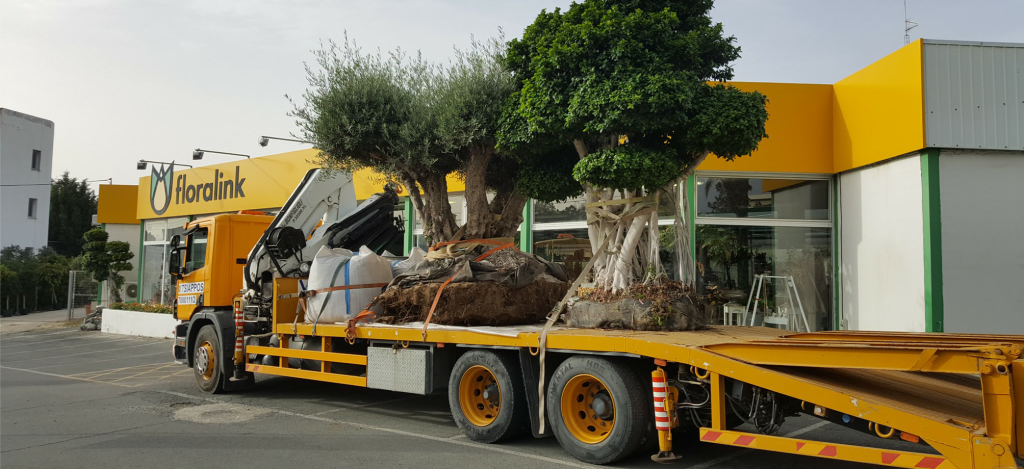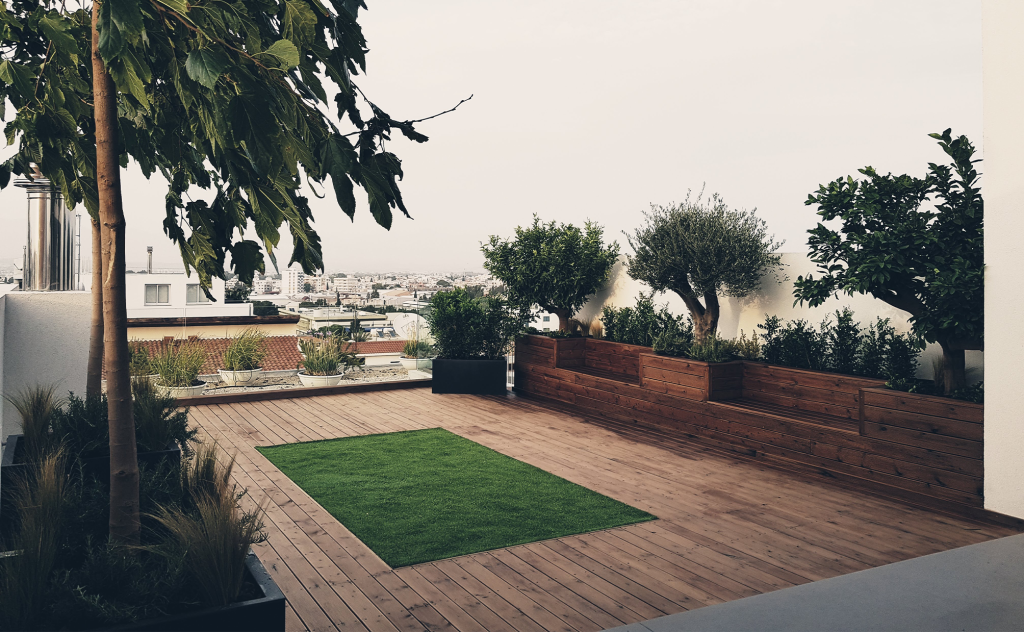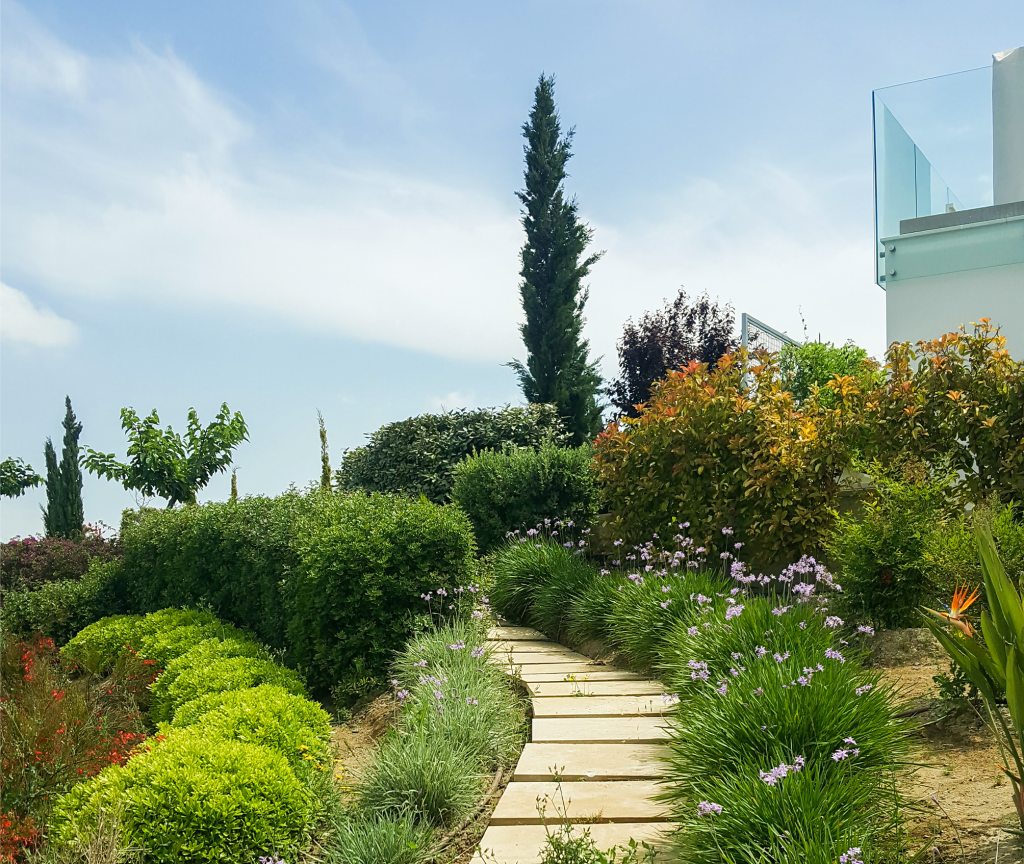Andreas Adamou, one of the owners of Floralink Suppliers Ltd and Store Manager in Nicosia, with studies in Agriculture, Garden Architecture & Landscape, could be the best friend of your garden, as he knows all its “secrets” and every need it has.
With knowledge and extensive experience in the “quiver,” Mr. Adamou responds in detail and thoroughly to our questions regarding garden architecture, gardening, suitable plants for our country, as well as factors that can affect the cost of designing and implementing various types of gardens. Among other things, he refers to current trends as well as timeless ones, gives advice for the proper selection of plants and trees based on our personal needs, and even in cases where we have pets.
Interview by Nicola Karatzia
Translation by Stephie Karagiorge
Photographic material: Floralink Suppliers Ltd
What exactly does garden architecture entail, and how does it differ from gardening?
Essentially, they are two distinct approaches to landscaping and gardening. Garden architecture deals with the design and configuration of space around a structure, such as a house or a business. It focuses on creating functional, aesthetically appealing, and captivating outdoor spaces that complement the architecture of each structure. On the other hand, gardening concerns the care, management, and maintenance of plants and the garden to keep them in excellent condition. It includes tasks like planting, watering, fertilizing, weed removal, protecting plants and trees from diseases and pests.
Often, photographic material found on the internet serves as a reference point for the garden we dream of for our home. However, is its implementation entirely feasible?
It is true that the photographic material we come across can be an excellent source of inspiration for the garden we envision, as well as aid the professionals we choose to better understand our “vision” regarding the desired outcome. Through the photos we will choose, conclusions can be drawn about the style of the garden that we imagine, the decorative elements, the layout and use of our outdoor spaces, the different types of plants and trees of our choice, and how they would work in combination.
Indeed, in this way, the overall cost of implementing this particular design will be estimated, thus determining our budget.
However, it is important to remember that the photos might depict gardens that are designed for specific climatic conditions and geographic regions, whose adaptation into our own environment may require modifications. Also, it is good to be aware that the garden of our dreams carries within it the practical aspect of its subsequent frequent care and maintenance, which might potentially demand more time and effort and could cost more than we would anticipate.
Have you ever found yourself in strong disagreement with a client’s wishes, and if so, how do you handle such situations?
As a professional, yes, it is possible to disagree with a client’s desires when it comes to the design or execution of a project. In such cases, my approach is always professional and respectful of the person I am dealing with. After all, their needs and preferences take precedence even if we disagree. The truth is that I believe in discussing and exchanging viewpoints without being dismissive of ideas. I always explain my concerns if any exist, and in cases of disagreement, I propose alternative solutions, presenting compromise proposals and solutions that might align with the client’s wishes, while simultaneously analyzing the merits of each approach separately.
In rare instances where it is not possible to find a common ground and the client insists on an idea that doesn’t meet professional standards or our company’s values, it might be necessary to decline the collaboration. However, even in such cases, this would still be done with courtesy and respect.
What parameters should be considered before proposing a design to clients?
A professional who offers design and solutions to their clients must take into account various factors before proceeding with the preparation of the plan. Some of these include:
• Budget: Understanding the available budget is essential so that the design is sustainable and feasible within the client’s financial framework.
• Personal Taste and Preferences: Each client is unique, with different preferences, personal taste, and functional needs, parameters that the professional will discover through a discussion that will precede and which must be taken into account during the design process.
• Climate and Weather Conditions: In certain regions, climate and weather conditions can significantly impact the design. For example, a house in an area with severe winter weather conditions requires different solutions compared to a house in a warm and sunny region.
• Infrastructure: Existing infrastructure such as water supply, soil composition, and electricity must be taken into account, as they can limit design possibilities.

The suitability of trees and plants is indeed linked, as you mentioned before, to the weather conditions of a country. So, in Cyprus, which species would you say are highly recommended?
The choice of trees and plants in a country like Cyprus depends on many factors, including climate conditions, soil diversity, and local needs. Below, I will mention some species – from a wide variety – that are recommended:
• Aromatic plants: Thyme (Thymus vulgaris), Oregano (Origanum vulgare), Mint (Mentha spp.), Lavender (Lavandula spp.).
• Fruit trees: Lemon tree (Citrus limon), Orange tree (Citrus sinensis), Mandarin tree (Citrus reticulata), Pomegranate tree (Punica granatum), Fig tree (Ficus carica).
• Trees: Olive tree (Olea europaea), Cypress tree (Cupressus sempervirens), Mastic tree (Schinus terebinthifolia), Aryan Drys or Oak (Quercus ilex).
• Shrubs: (Pistachio lentiscus), Myrtle (Myrtus communis), Bay Laurel (Laurus nobilis).
• Climbing plants: Jasmine (Jasminum spp.), Bougainvillea (Bougainvillea spp.), Stephanotis (Stephanotis floribunda), Honeysuckle (Lonicera japonica).
Species that are probably not so recommended for our country are those that require a tropical climate (excessive water and high humidity).
Does suitability vary even from city to city due to weather conditions and soil?
Indeed, this is true. Climatic conditions (temperature, humidity, rainfall) as well as soil conditions (clayey, sandy, organic soil) of the region where we reside must always be studied before selecting the plants and trees to be planted, to ensure their long-term sustainability.
In a newly built house that is under construction, at what point should the provision of services for garden design and preparation begin?
The design and preparation of the garden can start at various stages preceding the completion of a house. It is considered important for the garden work to be synchronized with the progress and evolution of the construction, and that the result is in harmony with the overall architecture and functionality of the space.
The three stages followed for the creation of a garden are:
• Design: Collaborate with a garden or landscape design expert to create a plan that aligns with the architecture of the house and your needs.
• Soil Preparation: Depending on the condition of the soil, it might be necessary to remove stones, roots, and other obstacles, as well as to level the soil surface.
• Infrastructure: If you are planning to have irrigation, lighting, or other infrastructure in the garden, these should be planned and installed in a timely manner.

Based on the style of a residence, are different types of plants suitable for maintaining overall harmony? If so, what would be suitable for a modern architectural house, a more classic one, and a traditional one?
Certainly, the choice of plants can be tailored to the style of a residence to create a harmonious result in its outdoor space.
In a modern house with “clean” lines and a contemporary style, the selection should be simple and subtle. Materials in neutral colors such as white, gray, and black are recommended, so the plants should be in shades of green.
In a classic or traditional house, a greater variety of plant species and trees can be used, with various foliage and flower colors. However, classic and traditional houses often feature warm colors such as red, orange, yellow, and brown. Horticultural combinations in corresponding shades of flowers and leaves can enhance the “character” of such a residence.
Can the maintenance of a garden be left solely in the hands of its owner, or does it require the expertise of a professional gardener for its upkeep?
The maintenance of a garden requires experience, skills, and knowledge, as there are many factors that need to be taken into consideration to keep it healthy.
The person taking care of it must have a deep knowledge of the plants and specific needs of each species, recognizing the different requirements in terms of planting, watering, fertilizing, and overall care. They should be able to identify any plant diseases and address them promptly. Knowing how to prune properly, an important factor for the growth and spaciousness of the garden.
Lastly, a good professional will manage their time wisely, with proper planning of maintenance works, so that the garden is kept in good condition all year round.
In case we purchase a house with an already landscaped garden, is it possible to completely remodel it? If yes, how time-consuming and costly would it be?
Yes, a complete remodelling of a garden is possible. This process can potentially be quite challenging, demanding, time-consuming, and costly due to a number of factors that may exist, which I will elaborate on below.
• Existing Structures and Plants: The first and most crucial decision you will need to make is whether to retain some of the existing plants, structures, or elements in the garden. If you plan to remove and replace many of these, the process will become more complex.
• Design: Creating a new garden design requires careful study. The layout of the space, climatic conditions, your needs, and the desired style must all be taken into consideration.
• Works: The redevelopment of a garden may involve various tasks such as clearing the area, removing old plants, demolishing structures, leveling the surface, installing new plants, constructing features, and installing irrigation.
• Materials: The cost of materials such as plants, stones, wood, decorative elements, depends on the type and quantity to be used.
• Professionals: If specialization is required for certain tasks such as the demolition of structures and installation of irrigation systems, professionals should be hired, which will increase the final cost.
Are there fashion trends in gardens? If yes, which ones are considered timeless?
Yes, there are trends in garden design, just as there are in fashion or interior design. Each era and period has its own characteristics; however, there are certain styles that have been established as timeless. Among these is the “Natural Garden“, which resembles nature, with forms and plants that appear to have grown naturally. The “English Garden” is another, which is more romantic, featuring an abundance of flowers, small pathways, and a free-flowing layout. Lastly, there is the “Mediterranean Garden“, with characteristic Mediterranean plants such as olive trees, lavender, and cypresses.
And which trends are prevailing currently?
Current trends in garden design would include:
• Sustainable Garden: It focuses on using resilient, locally adapted plants with minimal water and chemical needs.
• Minimalist Garden: The design focuses on a simple and clean style, with calculated lines and limited elements.
• Food Gardens: They have become popular where ornamental and functional plantings coexist for food production.
• Trend Gardens: They include plants that are popular in the current season, either because of their colors or their “emotional” value.
• Ecological Gardens: The trend is moving towards creating gardens that support biodiversity and local ecology.
• Technologically Advanced Gardens: The use of technology, such as “smart” irrigation and lighting systems, can enhance functionality and the user experience of the space.
• Low-Maintenance Gardens: With more people having limited time for garden care, they are choosing plants and designs that require less maintenance.

If we have pets at home, are there any prohibitive factors in selecting specific plants and trees?
Having pets and a garden can be a wonderfully combined experience, which however requires careful planning and care to maintain the health, well-being, and safety of our pets.
Therefore, it is crucial to choose non-toxic plants that, even if consumed by our four-legged companions, won’t result in poisoning. It is also important for our plants to be resistant to “pruning” and damage from any potentially destructive “games” our pets might engage in.
In addition to selecting trees and plants, we should adhere to certain hygiene and cleanliness rules, thereby creating safety measures for both our pets and ourselves. As a result, we apply anti-parasitic products to our pets to protect them from parasites that may exist in the garden, whilst at the same time, we regularly clean up feces and other waste.
Lastly, it would be useful to create an entirely safe area in the garden – especially for our pets – where they can play freely, providing them with engaging activities such as food-searching games. This would keep them creatively occupied, minimizing the chances of them causing damage out of boredom.

Closing, I would like to know what could potentially significantly increase the cost of a garden.
Prices for garden design can vary depending on the client’s requirements, the region, the type and size of the garden, the estimated working time, and the materials and types of plants/flowers/trees that will be selected. If complex structures are included, such as pathways, bridges, water features, ponds, pools, or if specialized design is required for lighting, irrigation automation, provisions for event hosting, the cost certainly increases significantly.
However, it is worth mentioning that designing a beautiful garden is a worthwhile investment that can add value to our property and provide countless hours of personal enjoyment.

